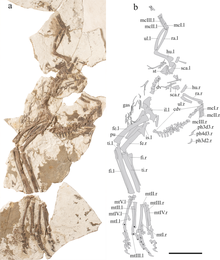
Oviraptor is a genus of oviraptorid dinosaur that lived in Asia during the Late Cretaceous period. The first remains were collected from the Djadokhta Formation of Mongolia in 1923 during a paleontological expedition led by Roy Chapman Andrews, and in the following year the genus and type species Oviraptor philoceratops were named by Henry Fairfield Osborn. The genus name refers to the initial thought of egg-stealing habits, and the specific name was intended to reinforce this view indicating a preference over ceratopsian eggs. Despite the fact that numerous specimens have been referred to the genus, Oviraptor is only known from a single partial skeleton regarded as the holotype, as well as a nest of about fifteen eggs and several small fragments from a juvenile.

Caudipteryx is a genus of small oviraptorosaur dinosaurs that lived in Asia during the Early Cretaceous, around 124.6 million years ago. They were feathered and extremely birdlike in their overall appearance, to the point that some paleontologists sugegsted it was a bird. Two species have been described: C. zoui, in 1998, and C. dongi, in 2000.
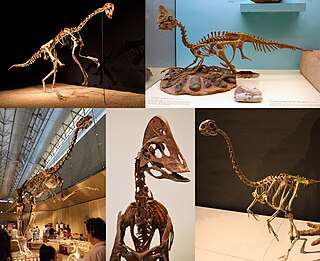
Oviraptorosaurs are a group of feathered maniraptoran dinosaurs from the Cretaceous Period of what are now Asia and North America. They are distinct for their characteristically short, beaked, parrot-like skulls, with or without bony crests atop the head. They ranged in size from Caudipteryx, which was the size of a turkey, to the 8-meter-long, 1.4-ton Gigantoraptor. The group is close to the ancestry of birds. Some researchers such as Maryanska et al (2002) and Osmólska et al. (2004) have proposed that they may represent primitive flightless birds. The most complete oviraptorosaur specimens have been found in Asia. The North American oviraptorosaur record is sparse.

Alectrosaurus is a genus of tyrannosauroid theropod dinosaur that lived in Asia during the Late Cretaceous period, about some 96 million years ago in what is now the Iren Dabasu Formation.

Caenagnathasia is a small caenagnathid oviraptorosaurian theropod from the Late Cretaceous of Uzbekistan.
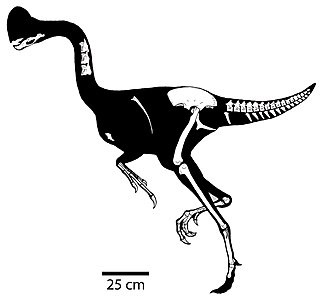
Chirostenotes is a genus of oviraptorosaurian dinosaur from the late Cretaceous of Alberta, Canada. The type species is Chirostenotes pergracilis.

Caenagnathus is a genus of caenagnathid oviraptorosaurian dinosaur from the late Cretaceous period. It is known from partial remains including lower jaws, a tail vertebra, hand bones, and hind limbs, all found in the Dinosaur Park Formation of Alberta, Canada. Caenagnathus measured about 2.5 m (8.2 ft) long and weighed about 96–100 kg (212–220 lb).

Citipati is a genus of oviraptorid dinosaur that lived in Asia during the Late Cretaceous period, about 75 million to 71 million years ago. It is mainly known from the Ukhaa Tolgod locality at the Djadochta Formation, where the first remains were collected during the 1990s. The genus and type species Citipati osmolskae were named and described in 2001. A second species from the adjacent Zamyn Khondt locality may also exist. Citipati is one of the best-known oviraptorids thanks to a number of well-preserved specimens, including individuals found in brooding positions atop nests of eggs, though most of them were initially referred to the related Oviraptor. These nesting specimens have helped to solidify the link between non-avian dinosaurs and birds.

Incisivosaurus is a genus of small, probably herbivorous theropod dinosaurs from the early Cretaceous Period of what is now the People's Republic of China. The first specimen to be described, IVPP V13326, is a skull that was collected from the lowermost levels of the Yixian Formation in the Sihetun area, near Beipiao City, in western Liaoning Province. The most significant, and highly unusual, characteristic of this dinosaur is its apparent adaptation to an herbivorous or omnivorous lifestyle. It was named for its prominent, rodent-like front teeth, which show wear patterns commonly found in plant-eating dinosaurs. The specific name gauthieri honors Dr. Jacques Gauthier, a pioneer of the phylogenetic method of classification.
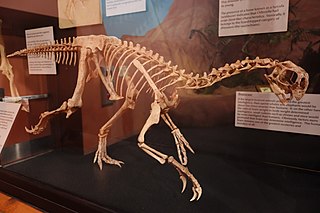
Heyuannia is a genus of oviraptorid dinosaur that lived in Asia during the Late Cretaceous epoch, in what is now China and Mongolia. It was the first oviraptorid found in China; most others were found in neighbouring Mongolia. Two species are known: H. huangi, named by Lü Junchang in 2002 from the Dalangshan Formation; and H. yanshini, originally named as a separate genus Ingenia from the Barun Goyot Formation by Rinchen Barsbold in 1981, and later renamed to Ajancingenia in 2013 due to the preoccupation of Ingenia. The latter name was eventually discarded due to various ethical issues surrounding the author.

Elmisaurus is an extinct genus of caenagnathid dinosaur from the Late Cretaceous Nemegt Formation of Mongolia. It was a theropod belonging to the Oviraptorosauria.

The Barun Goyot Formation is a geological formation dating to the Late Cretaceous Period. It is located within and is widely represented in the Gobi Desert Basin, in the Ömnögovi Province of Mongolia.

The Nemegt Formation is a geological formation in the Gobi Desert of Mongolia, dating to the Late Cretaceous. The formation consists of river channel sediments and contains fossils of fish, turtles, crocodilians, and a diverse fauna of dinosaurs, including birds.

Caenagnathidae is a family of derived caenagnathoid dinosaurs from the Cretaceous of North America and Asia. They are a member of the Oviraptorosauria, and relatives of the Oviraptoridae. Like other oviraptorosaurs, caenagnathids had specialized beaks, long necks, and short tails, and would have been covered in feathers. The relationships of caenagnathids were long a puzzle. The family was originally named by Raymond Martin Sternberg in 1940 as a family of flightless birds. The discovery of skeletons of the related oviraptorids revealed that they were in fact non-avian theropods, and the discovery of more complete caenagnathid remains revealed that Chirostenotes pergracilis, originally named on the basis of a pair of hands, and Citipes elegans, originally thought to be an ornithomimid, named from a foot, were caenagnathids as well.
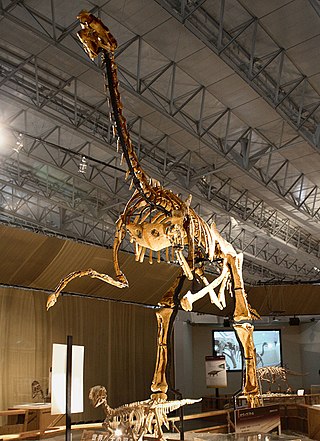
Gigantoraptor is a genus of large oviraptorosaur dinosaur that lived in Asia during the Late Cretaceous period. It is known from the Iren Dabasu Formation of Inner Mongolia, where the first remains were found in 2005.
The Nanxiong Formation is a Late Cretaceous geologic formation in Guangdong Province. Dinosaur remains are among the fossils that have been recovered from the formation.
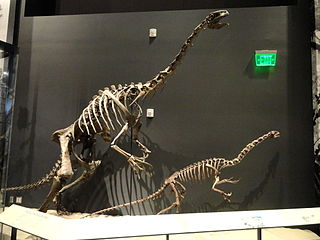
The timeline of therizinosaur research is a chronological listing of events in the history of paleontology focused on therizinosaurs. They were unusually long-necked, pot-bellied, and large-clawed herbivorous theropods most closely related to birds. The early history of therizinosaur research occurred in three phases. The first phase was the discovery of scanty and puzzling fossils in Asia by the Central Asiatic Expeditions of the 1920s and Soviet-backed research in the 1950s. This phase resulted in the discovery of the Therizinosaurus cheloniformis type specimen. Soviet paleontologist Evgeny Maleev interpreted these unusual remains as belonging to some kind of gigantic turtle.

This timeline of oviraptorosaur research is a chronological listing of events in the history of paleontology focused on the oviraptorosaurs, a group of beaked, bird-like theropod dinosaurs. The early history of oviraptorosaur paleontology is characterized by taxonomic confusion due to the unusual characteristics of these dinosaurs. When initially described in 1924 Oviraptor itself was thought to be a member of the Ornithomimidae, popularly known as the "ostrich" dinosaurs, because both taxa share toothless beaks. Early caenagnathid oviraptorosaur discoveries like Caenagnathus itself were also incorrectly classified at the time, having been misidentified as birds.
